KubarychGroup
Multidimensional spectroscopy is a nonlinear optical technique where three field interactions (we don’t want to talk about photons for now), conspire to induce a third-order nonlinear polarization in the material. The polarization radiates an electric field, which we detect using an interferometry technique. The information in the signal field is the three-point time correlation function of the dipole operator. The three time intervals may be converted to frequencies by Fourier transformation (or partial transformations), and the resulting amplitude map is plotted in two (or more) dimensions.
A Closer Look...

Chirped Pulse Upconversion
Using a beam that is automatically available in any laser system used to do 2DIR spectroscopy, we perform an additional nonlinear optical process where the infrared electric fields (orange above) are “upconverted” with a long chirped pulse centered at 800 nm. The result is a visible signal that can easily be detected using a conventional silicon CCD camera in a spectrometer. The effects of the chirp are readily removed from the measured spectra.
Fourier Transform 2D Spectroscopy




excite
detect
twait
The cartoon boxes are actually a set of three pulses. The emitted signal field is detected in a spectrometer, giving the detection frequency directly. The Fourier transform with respect to t1 gives the excitation frequency axis. All pulses used are 10-100 femtoseconds in duration, giving broad bandwidth and high time resolution.









400 ps
5-10 ps


